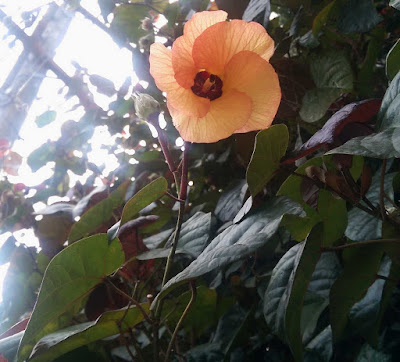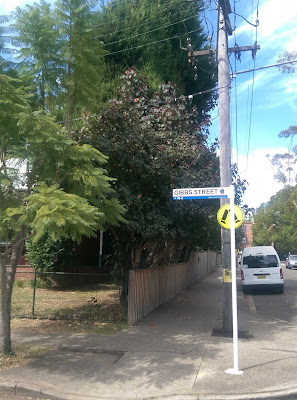Subtle colours in the proud Sydney sun
It was late summer in the inner west of Sydney, a week or two after the Mardi Gras but nobody told the street trees. There were crepe myrtles in vivid pink and purple, Tibouchina in that irridescent blue you only see otherwise in parades and festivals, and every now and then, bursting out from a tiny front yard, a giant pom-pom of ice-creamy frangipani.
So what does this Melburnian do in such an visually charged streetscape? I notice an odd form of the Coast or Sea Hibiscus. The yellow-flowered Hibiscus tiliaceus (also classified as Talipariti tiliaceum by some) is exotic and adventurous in its own way, travelling as it does around the world taking root on tropical and subtropical shores. My memories of it are from Borneo, some island off Queensland and Sydney's Royal Botanic Garden, but it is native to much of northern Australia and much of the pantropical world.
You can eat it, preferably wrapped around something else a little tastier, or eat off it (as a plate). In Australia I gather roots and shoots are eaten by Indigenous peoples in the north, and there are a range of medicinal benefits associated with the ingestion of leaves, bark and flowers - but as if often the case, on of those 'benefits' is as a laxative.
Now the flower in that top picture is clearly orange, not yellow. That's presumably because the flowers of the species open yellow in the morning and redden up later in the day. I only remember them as yellow, but perhaps that's because I tend to botanise idly in the mornings. This picture was around brunch time but perhaps they were yesterday's flowers.
The hint of red in the leaves, however, suggests a well-known cultivar. Hibiscus tiliaceus 'Rubra', sometimes called the Red or Bronze Cottonwood, is I think what grabbed my attention that steamy warm day in Sydney. My pictures were stolen glimpses as we walked past (not the high photographic art you are used to...) but it's a smart looking tree with deep green leaves with hints of bronze, and pale apricot orange flowers.
This cultivar does grow in Melbourne and we have a coppice of youngish plants in the [Rhododendron] Vireya Bed at Melbourne Gardens, near the Ornamental Lake east of the Rose Pavilion. There were not in flower in March (or now) but they look pretty enough in leaf. Sometimes you have to travel far away to appreciate what is close at hand, or some such glib saw.
Speaking of wood cutting devices, in a recent paper demonstrating how a brittle volcanic glass (obsidian) was used to make axe blades many thousands of years ago in Papua New Guinea, local craftsman used both Hibiscus tiliaceus and Hibiscus tiliaceus 'Rubra' to make a light but hard axe handle for a reconstructed archaeological tools. I'm not sure what this says about the origin of the cultivar 'Rubra' but perhaps it occurs naturally in this region.
This cultivar does grow in Melbourne and we have a coppice of youngish plants in the [Rhododendron] Vireya Bed at Melbourne Gardens, near the Ornamental Lake east of the Rose Pavilion. There were not in flower in March (or now) but they look pretty enough in leaf. Sometimes you have to travel far away to appreciate what is close at hand, or some such glib saw.
Speaking of wood cutting devices, in a recent paper demonstrating how a brittle volcanic glass (obsidian) was used to make axe blades many thousands of years ago in Papua New Guinea, local craftsman used both Hibiscus tiliaceus and Hibiscus tiliaceus 'Rubra' to make a light but hard axe handle for a reconstructed archaeological tools. I'm not sure what this says about the origin of the cultivar 'Rubra' but perhaps it occurs naturally in this region.
To most of us the flower of the hibiscus is the attractant. I've blogged plenty of times about Hibiscus species, or its relatives in the family Malvaceae, and I'm being a little disingenuous saying they aren't Madi Gras standard. There flowers are hard to miss, and frequently bold and brash. It was just in this setting they were bystanders to the parade of pinks, purples and blues.
And rest assured my head is turned by flower colours in that spectrum. This is the shrub I photographed, with a small Jacaranda to its left. If that Jacaranda had been in full purple haze (or purple rain, if that's your thing) I wouldn't have taken a second glance at the Hibiscus.
Feedback: Lynda Newnam responded (3 May 2016) to this post on Facebook, noting that Cotton Tree gives it name to a beautiful spot in Maroochydore, Queensland, posting the following 'postcard':
And rest assured my head is turned by flower colours in that spectrum. This is the shrub I photographed, with a small Jacaranda to its left. If that Jacaranda had been in full purple haze (or purple rain, if that's your thing) I wouldn't have taken a second glance at the Hibiscus.
Feedback: Lynda Newnam responded (3 May 2016) to this post on Facebook, noting that Cotton Tree gives it name to a beautiful spot in Maroochydore, Queensland, posting the following 'postcard':




Comments
but I thought you might be able to answer my question.
I have a hibiscus tiliaceus rubra tree in my garden.
I planted it about 4yrs ago as a screening tree.
It was fast growing & a beautiful small tree, it’s about 3-4mts high now.
In the past 4mths or so the majority of the leaves have turned brown.
And it looks like my lovely native hibiscus tree is dying.
Does anyone know why this could be?
I haven’t noticed it do this before so it can’t be a seasonal thing.
There are a few lower branches with a few green leaves.
I would appreciate any feedback. Thanks, Jen
but I thought you might be able to answer my question.
I have a hibiscus tiliaceus rubra tree in my garden.
I planted it about 4yrs ago as a screening tree.
It was fast growing & a beautiful small tree, it’s about 3-4mts high now.
In the past 4mths or so the majority of the leaves have turned brown.
And it looks like my lovely native hibiscus tree is dying.
Does anyone know why this could be?
I haven’t noticed it do this before so it can’t be a seasonal thing.
There are a few lower branches with a few green leaves.
I would appreciate any feedback. Thanks, Jen
We had drought then a flood earlier this year (northern nsw) 🤷♀️
We had drought then a flood earlier this year (northern nsw) 🤷♀️